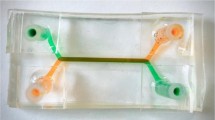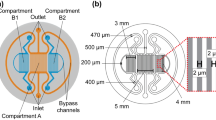Abstract
For successful cell culture in microfluidic devices, precise control of the microenvironment, including gas transfer between the cells and the surrounding medium, is exceptionally important. The work is motivated by a polydimethylsiloxane (PDMS) microfluidic oxygenator chip for mammalian cell culture suggesting that the speed of the oxygen transfer may vary depending on the thickness of a PDMS membrane or the height of a fluid channel. In this paper, a model is presented to describe the oxygen transfer dynamics in the PDMS microfluidic oxygenator chip for mammalian cell culture. Theoretical studies were carried out to evaluate the oxygen profile within the multilayer device, consisting of a gas reservoir, a PDMS membrane, a fluid channel containing growth media, and a cell culture layer. The corresponding semi-analytical solution was derived to evaluate dissolved oxygen concentration within the heterogeneous materials, and was found to be in good agreement with the numerical solution. In addition, a separate analytical solution was obtained to investigate the oxygen pressure drop (OPD) along the cell layer due to oxygen uptake of cells, with experimental validation of the OPD model carried out using human umbilical vein endothelial cells cultured in a PDMS microfluidic oxygenator. Within the theoretical framework, the effects of several microfluidic oxygenator design parameters were studied, including cell type and critical device dimensions.







Similar content being viewed by others
References
Allen JW, Bhatia SN (2003) Formation of steady-state oxygen gradients in vitro—application to liver zonation. Biotechnol Bioeng 82(3):253–262
Beebe DJ, Mensing GA, Walker GM (2002) Physics and applications of microfluidics in biology. Annu Rev Biomed Eng 4:261–286
Brischwein M, Motrescu ER, Cabala R et al (2003) Functional cellular assays with multiparametric silicon sensor chips. Lap Chip 3(4):234–240
Chakraborty S, Balakotaiah V, Bidani A (2007) Multiscale model for pulmonary oxygen uptake and its application to quantify hypoxemia in hepatopulmonary syndrome. J Theor Biol 244(2):190–207
Conte SD, deBoor C (1972) Elementary numerical analysis. McGraw-Hill, New York
Cuvelier D, Thery M, Chu YS et al (2007) The universal dynamics of cell spreading. Curr Biol 17(8):694–699
De Bartolo L, Salerno S, Morelli S et al (2006) Long-term maintenance of human hepatocytes in oxygen-permeable membrane bioreactor. Biomaterials 27(27):4794–4803
Farahat WA, Wood LB, Zervantonakis IK et al (2012) Ensemble analysis of angiogenic growth in three-dimensional microfluidic cell cultures. PLoS ONE 7(5):e37333
Fredman TP (2003) An analytical solution method for composite layer diffusion problems with an application in metallurgy. Heat Mass Transf 39(4):285–295
Germain S, Monnot C, Muller L, Eichmann A (2010) Hypoxia-driven angiogenesis: role of tip cells and extracellular matrix scaffolding. Curr Opin Hematol 17(3):245–251
Higgins JM, Eddington DT, Bhatia SN, Mahadevan L (2007) Sickle cell vasoocclusion and rescue in a microfluidic device. Proc Natl Acad Sci USA 104(51):20496–20500
Houston KS, Weinkauf DH, Stewart FF (2002) Gas transport characteristics of plasma treated poly (dimethylsiloxane) and polyphosphazene membrane materials. J Membr Sci 205(1–2):103–112
Kane BJ, Zinner MJ, Yarmush ML, Toner M (2006a) Liver-specific functional studies in a microfluidic array of primary mammalian hepatocytes. Anal Chem 78(13):4291–4298
Kane BJ, Zinner MJ, Yarmush ML, Toner M (2006b) Liver-specific functional studies in a microfluidic array of primary mammalian hepatocytes. Anal Chem 78(13):4291–4298
Lam RHW, Kim MC, Thorsen T (2009) Culturing aerobic and anaerobic bacteria and mammalian cells with a microfluidic differential oxygenator. Anal Chem 81(14):5918–5924
Leclerc E, Sakai Y, Fujii T (2004) Microfluidic PDMS (polydimethylsiloxane) bioreactor for large-scale culture of hepatocytes. Biotechnol Prog 20(3):750–755
Masterton WL, Hurley CN (2002) Chemistry: principles and reactions. Thomson Books/Cole, Belmont
McDonald JC, Duffy DC, Anderson JR et al (2000) Fabrication of microfluidic systems in poly(dimethylsiloxane). Electrophoresis 21(1):27–40
Mulholland GP, Cobble MH (1972) Diffusion through composite media. Int J Heat Mass Transf 15(1):147–160
Park J, Bansal T, Pinelis M, Maharbiz MM (2006) A microsystem for sensing and patterning oxidative microgradients during cell culture. Lab Chip 6(5):611–622
Pathi P, Ma T, Locke BR (2005) Role of nutrient supply on cell growth in bioreactor design for tissue engineering of hematopoietic cells. Biotechnol Bioeng 89(7):743–758
Patton JN, Palmer AF (2006) Numerical simulation of oxygen delivery to muscle tissue in the presence of hemoglobin-based oxygen carriers. Biotechnol Prog 22(4):1025–1049
Polinkovsky M, Gutierrez E, Levchenko A, Groisman A (2009) Fine temporal control of the medium gas content and acidity and on-chip generation of series of oxygen concentrations for cell cultures. Lab Chip 9(8):1073–1084
Poulsen L, Zebger I, Tofte P et al (2003) Oxygen diffusion in bilayer polymer films. J Phys Chem B 107(50):13885–13891
Radisic M, Deen W, Langer R, Vunjak-Novakovic G (2005) Mathematical model of oxygen distribution in engineered cardiac tissue with parallel channel array perfused with culture medium containing oxygen carriers. Am J Physiol Heart Circ Physiol 288(3):H1278–H1289
Radisic M, Malda J, Epping E, Geng W, Langer R, Vunjak-Novakovic G (2006a) Oxygen gradients correlate with cell density and cell viability in engineered cardiac tissue. Biotechnol Bioeng 93(2):332–343
Radisic M, Park H, Chen F et al (2006b) Biomirnetic approach to cardiac tissue engineering: oxygen carriers and channeled scaffolds. Tissue Eng 12(8):2077–2091
Roy P, Baskaran H, Tilles AW, Yarmush ML, Toner M (2001) Analysis of oxygen transport to hepatocytes in a flat-plate microchannel bioreactor. Ann Biomed Eng 29(11):947–955
Shiku H, Saito T, Wu CC et al (2006) Oxygen permeability of surface-modified poly(dimethylsiloxane) characterized by scanning electrochemical microscopy. Chem Lett 35(2):234–235
Sud D, Mehta G, Mehta K et al (2006) Optical imaging in microfluidic bioreactors enables oxygen monitoring for continuous cell culture. J Biomed Optics 11(5):050504
Szita N, Boccazzi P, Zhang Z et al (2005) Development of a multiplexed microbioreactor system for high-throughput bioprocessing. Lab Chip 5(8):819–826
Tan JL, Tien J, Pirone M, Gray DS et al (2003) Cells lying on a bed of microneedles: an approach to isolate mechanical force. Proc Natl Acad Sci USA 100(4):1484–1489
Thorsen T, Maerkl SJ, Quake SR (2002) Microfluidic large-scale integration. Science 298(5593):580–584
Toh YC, Zhang C, Zhang J et al (2007) A novel 3D mammalian cell perfusion-culture system in microfluidic channels. Lab Chip 7(3):302–309
Tourovskaia A, Figueroa-Masot X, Folch A (2005) Differentiation-on-a-chip: a microfluidic platform for long-term cell culture studies. Lab Chip 5(1):14–19
Valeur B, Brochon JC (2001) New trends in fluorescence spectroscopy: applications to chemical and life. Springer, New York, p 236
Vickerman V, Blundo J, Chung S, Kamm R (2008) Design, fabrication and implementation of a novel multi-parameter control microfluidic platform for three-dimensional cell culture and real-time imaging. Lab Chip 8(9):1468–1477
Vollmer AP, Prostein RF, Gilbert R, Thorsen T (2005) Development of an integrated microfluidic platform for dynamic oxygen sensing and delivery in a flowing medium. Lab Chip 5(10):1059–1066
Wang Z, Kim MC, Marquez M, Thorsen T (2007) High-density microfluidic arrays for cell cytotoxicity analysis. Lab Chip 7(6):740–745
Zanzotto A, Szita N, Schmidt MA, Jensen KF (2002) 2nd annual international IEEE-EMBS special topic conference on microtechnologies in medicine & biology 164–168. Madison, Wisconsin, USA
Zhang ZY, Boccazzi P, Choi HG et al (2006) Microchemostat—microbial continuous culture in a polymer-based, instrumented microbioreactor. Lab Chip 6(7):906–913
Ziomek E, Kirkpatrick N, Reid ID (1991) Effect of poldimethyl siloxane oxygen carriers on the biological bleaching of hardwood kraft pulp by trametes-versicolor. Appl Microbiol Biotechnol 35(5):669–673
Acknowledgments
The authors thank the Singapore-MIT Alliance of Research and Technology for financial supports of this work. The authors would like to acknowledge the financial supports from Croucher Foundation, Early Career Scheme of Hong Kong Research Grant Council (Project# RGC124212), and the National Science Foundation under Grant No. EFRI-0735997 and Grant No. STC-0902396. The authors thank Sukhyun Song for his assistance on the HUVEC culture experiment.
Author information
Authors and Affiliations
Corresponding authors
Additional information
Min-Cheol Kim and Raymond H. W. Lam are equally contributed to this work.
Electronic supplementary material
Below is the link to the electronic supplementary material.
Rights and permissions
About this article
Cite this article
Kim, MC., Lam, R.H.W., Thorsen, T. et al. Mathematical analysis of oxygen transfer through polydimethylsiloxane membrane between double layers of cell culture channel and gas chamber in microfluidic oxygenator. Microfluid Nanofluid 15, 285–296 (2013). https://doi.org/10.1007/s10404-013-1142-8
Received:
Accepted:
Published:
Issue Date:
DOI: https://doi.org/10.1007/s10404-013-1142-8




